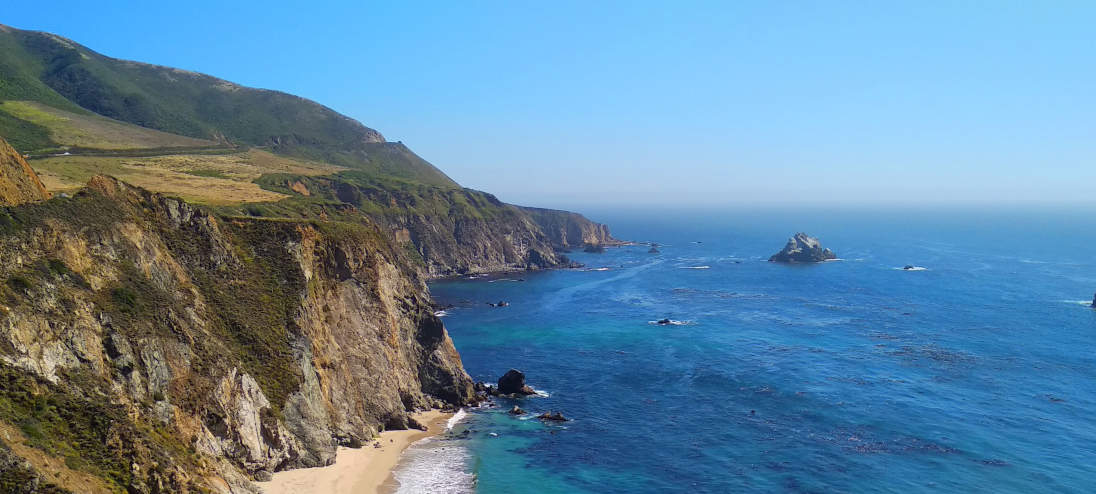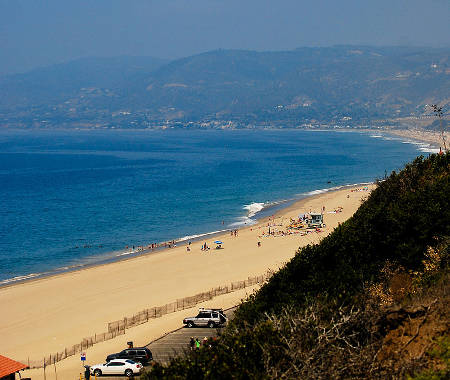
The coasts of California
California's magnificent coastline
About-California.com
- an essential introduction
- Explore California ►
- General information
- Places
to visit
- Los Angeles
- Hollywood
- San Francisco
- Sacramento
- The California coast
- Death valley
- Yosemite national park
- Bodie ghost town
- Other places to visit
- Things to do
- And other places
California's
ocean playground
California's
diverse coastline
With 840 miles (1350 km) of coastline, California has the third longest
coastline of any state in the USA. But stretching almost 650 miles -
over 1000 km - from north to south, it is a coastline that is very
different in the north, towards the border with Oregon, compared to the
southern coast that reaches down to the border with MexicoFrom the border with Oregon, down to as far as Malibu, even in the summer time the coastal waters of the Pacific Ocean are not warm. Average water temperatures for July, the warmest month, are a tolerable 65.8°F (18.8°C) at Malibu, but down to 56.9°F (13.9°C) at Monterey, and just 55.3°F (12.9°C) at San Francisco.
By way of comparison the July average sea temperature at Atlantic City (NJ) is 74°F (23.3°C), at Brighton (UK) it is 59.7°F (15.4°C), at Nice (France) it is 73.6°F (23.1°C), and at Benidorm (Spain) it is 77.1°F (25.1°C).
Even in southern California, sea water temperatures do not get up to Mediterranean or US East coast levels. The July average for Santa Barbara, not far north of Malibu, is a brisk 62.1°F (16.7°C) while right down by San Diego and the Mexican border, the July average at the very popular Coronado beach is still only 67°F (19.5°C).
The beaches and coast of Southern California
 Malibu beach.
Malibu beach.The long sandy beaches between Malibu and the Mexican border certainly attract the crowds; but apart from on the warmest sunniest days, only the hardy will go further than waist-deep into the waves, and those who do swim will not spend too long in the water.
But swimming is just one way to enjoy the ocean; there are others, starting with surfing. It is said that surfing, as a sport, began at Long Beach, and today surfing has become synonymous with southern California, and surfing beaches dot the coast from Santa Barbara down to San Diego. Southern California's sunny ocean beaches great places for relaxing, beach walking, paddling, building sand castles and other seaside pleasures.
The beaches and coast of Northern California
Hôtels
throughout California
A great selection at best rates
from Booking.com
:

Los
Angeles:

San Francisco
State-wide
Fog is a regular feature of the Pacific coastline in northern California, specially in summer.
Nevertheless, the beaches and coastline of Northern California have plenty of other attractions. Wildlife, such as sea birds and sea lions, is abundant; and long sandy beaches attract hikers, joggers and family outings. Many of the beaches on the coast north of San Francisco are off the beaten track, down small side roads off the very scenic coastal road, Highway 1, one of the best road-trip journeys in the United States (see California scenic routes). A trip up or down the northern part of Highway 1, between Leggett and San Francisco, is a trip to remember, as the highway hugs the coastline for most of the way.
Some special places to see on the California coast
Naturally, the California coastline has some special places, attractions that are worth making a detour to go and see.Here is a selection of ten sites, from north to south
- Redwoods national and state park - a UNESCO world natural heritage site. What remains of the large expanses of temperate rain forest that once covered this part of the Pacific coast. Home to the world's tallest trees. Website
- The Lost Coast - a wilderness area including the Kings Range National Conservation area - south of Eureka
- Mendocino - historic small town with all amenities. Historical landmark site. Website
- Bodega Bay - the small coastal town in which Hitchcock filmed the classic movie "the Birds"
- The Golden Gate bridge - the only northern entrance to / exit from San Francisco
- Santa Cruz - an old fashioned seaside resort, with historic amusement park, boardwalk and other attractions
- The Monterey aquarium. An amazing seawater aquarium that is actually connected to the sea. Big attractions include sharks, penguins and the cute sea otters. Mission: to inspire conservation of the world's oceans. Website
- Big Sur - one of the most dramatic sections of Highway 1, south of Monterey.
- Hearst Castle, San Simeon - National historic landmark. Flamboyant neo-hispanic seaside chateau built 1919-1947 for newspaper magnate Randolf Hearst.
- Carpinteria Harbor Seal Preserve and Rookery. Southeast of Santa Barbara, famed seal-breeding area. Website
About-California.com
Home
page
Driving
the length of the California coast, following the coastal highways (
mostly Highway 1 ), is a journey of about 1000 miles (1600 km). Allow at least 20
hours driving time, plus all the stops you will want to make.
Photo top of page by Ankit Dembla
Photo of Malibu beach by Steve Voght, cc-by-sa-2.0 license
Text and all other photos © About-California.com
About :
About-California.com is a Travel-Webs site
To contact this website please use the form provided.
Visiting
the California coast by train.
Amtrack's Pacific Surfliner route runs from San Luis Obispo, via Los
Angeles, to San Diego. Part of the route south of Los Angeles runs
right along the coast.
More coast
guides
Quebec
- the north shore of the St Lawrence - Quebec's highway 132
The coasts of France
The coasts of England
The coasts of France
The coasts of England
Other
places, other countries...
- About France - a thematic guide to France. Over 200 pages of information for visitors and students.
- About Britain - a thematic introduction to Britain
- About-Portugal.com - Discover Portugal and its regions
- About Quebec - Discover the French-speaking province of Canada
- About Spain - discover the real Spain - an incomplete guide to Spain on and off the beaten track
- Angleterre.org.uk - Le guide de l'Angleterre, en français
Photo top of page by Ankit Dembla
Photo of Malibu beach by Steve Voght, cc-by-sa-2.0 license
Text and all other photos © About-California.com
About :
About-California.com is a Travel-Webs site
To contact this website please use the form provided.
